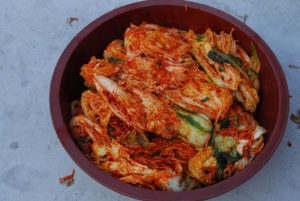
-Jenn Hawthorne-
Last month in the Charlottesville store, we had a workshop on fermentation. As I was teaching the class, I talked to one of the participants, and she had an amazing view on kimchi. I started the class thinking of kimchi as a finite, this is how you make it and this is the only way to make it thing. After my conversation, however, my eyes were opened to all the massive possibilities with this amazing food.
A little history about this dish makes you realize why it is a very important super food of sorts and should be in everyone’s diet. Kimchi is a common addition to Korean cuisine. It is a side dish made of salted and fermented vegetables. Most people commonly use napa cabbage, daikon radishes, and a variety of seasonings such as chili powder, paprika, scallions, garlic, ginger and jeotgal(salted seafood). The traditional preparation involves keeping it underground, but this is not necessary.
What I learned was an amazing slant on this dish. You do start with your brine, but the sky’s the limit on what you add. This is how I made it.
I started with Napa cabbage (shredded) and I added red cabbage, daikon radishes, and bok choy. Then I added scallions, minced garlic, carrots, apples, blueberries, cayenne peppers, grated ginger, a little sugar. I let it sit for a few days, and the result was sweet, tangy and spicy – in a word, delicious! I am not a seafood taste lover in my vegetables, so I opted out on the jeotgal.
The health benefits of kimchi are purported to be astounding, but are unproven at this point. As we know, fermented foods have been linked to longer, healthier lives in general. Kimchi is rich in vitamins A and C. Along with the added benefits of fermentation for the digestive system, it can have a positive effect on the physical, mental and emotional wellbeing of our bodies. The cultures that consume fermented food regularly (and have for centuries) tend to live longer and have fewer occurrences of cancer.
Below is an easy to follow recipe
In a large mixing bowl, combine the following:
(You may want to wear non-latex gloves to protect your hands and food from contaminants and spices)
1 large head of napa cabbage (shredded)
1 tbsp grated fresh garlic
¼ cup hot pepper of your choice (I use cayenne or jalapeno) (you can also use 2-3 tsp of hot pepper flakes
2 tsp fresh grated ginger
½ pound daikon radishes cut into matchstick sizes
6 scallions trimmed and cut into 1 inch pieces
1 cup apples (matchstick shapes)
2 cup full size carrots (matchstick shapes)
1 cup blueberries
3 cups red cabbage (shredded)
2 cups bok choy (cut into matchstick and shredded 2 inch sections)
Mix thoroughly. Place veggies inside of container(s) below:
1- 2 gallon jar with airlock OR 2 gallon crock with cover OR 2 – 1 gallon jars with airlocks
You will need a plate to place underneath crock for extra liquid spilling out.
In a gallon container, mix the following thoroughly.
1 gallon of purified water/filtered water
2 tsp sugar
2 tbsp chili powder
2 tsp paprika
¼ cup sea or kosher salt
Pour water mixture over veggies that are inside the container(s). Make sure that there is enough water to cover the top of the veggies. Use a weight if necessary to keep veggies covered with liquid. (You need to leave 2 inches of space between the top of liquid and top of container for gas expansion)
I split mine up evenly and put it into 2 one-gallon jars with our fermentation lids and airlocks and let it sit for 1 day for one and 5 for the other. I like it more fermented than the rest of my family.
When you are done fermenting, put the original lid on the jar and place in the fridge and you are ready to eat it. It is a sweet, spicy, tart side dish!
Happy Fermenting!!

Leave a Reply